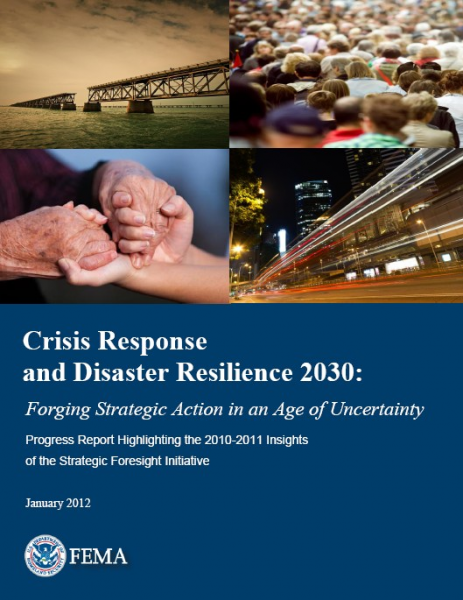You are here
Crisis Response and Disaster Resilience 2030: Forging Strategic Action in an Age of Uncertainty
Primary tabs
Crisis Response and Disaster Resilience 2030: Forging Strategic Action in an Age of Uncertainty
Wed, 2012-02-15 21:30 — Kathy Gilbeaux
This document is the product of our foresight work, and sets up the nature of strategic challenges facing the disaster resilience mission space over the next 20 years.
David J. Kaufman
Director, Office of Policy and Program Analysis
U.S. Department of Homeland Security/FEMA
As the emergency management community1 looks toward 2030, one thing is certain – the world will not look the same as it does today. Shifting demographics and the rate of technological innovation will challenge the way we plan and communicate with the public. Constraints on spending at all levels—federal, state, local, and tribal—are forcing and will continue to force us to rethink what activities we can truly afford to do and how to build partnerships to accomplish our objectives. At the same time, more frequent and more intense storms will present operational challenges and complexities. Any of these issues alone would challenge some current emergency management policies and procedures. In combination, these and other forces of change produce a difficult, highly uncertain future, the complexity of which will test the ability of the emergency management community to execute our mission. Exploring the nature of such future challenges can help us take actions to improve our Nation’s resilience and adaptability.
Launched in 2010, the Strategic Foresight Initiative (SFI) is a transformative, community-wide effort to create an enduring foresight capability. It is intended to advance strategic planning and thinking about the future, to prepare the community both for emerging challenges and for the key opportunities presented by our changing environment. Its core focus is to understand the factors driving change in our world, and to analyze how they will impact the emergency management field in the United States over the next 20 years. Thinking more broadly, rigorously, and over a longer timeframe will help us:
• Hedge against uncertainty;
• Avoid strategic surprises;
• Promote information sharing across disciplines and organizations;
• Understand what changes could affect emergency management; and
• Prepare and plan to more effectively operate in our future environment.
Fundamentally, the SFI seeks two outcomes: (1) an emergency management community prepared for whatever challenges the future holds; and (2) a common sense of direction and urgency, to drive action toward meeting our shared future needs—starting today. Achieving these objectives will require ongoing conversations among diverse stakeholders, the creation of a common sense of awareness, and leadership throughout the community to make the needed changes to prepare our Nation for the future.
This report is intended to provide planners and managers with insights that can shape a range of critical decisions, starting today. Such decisions—which can be made in advance of disasters— include improving prioritization of resources and investments, managing new and unfamiliar risks, forging new partnerships, and understanding emerging legal and regulatory hurdles.

Recent Comments